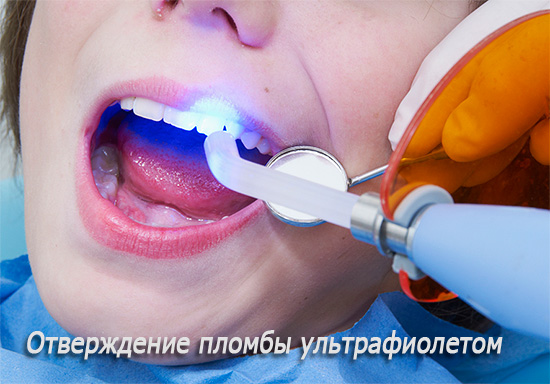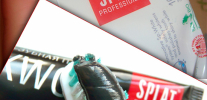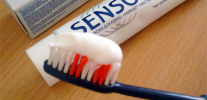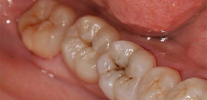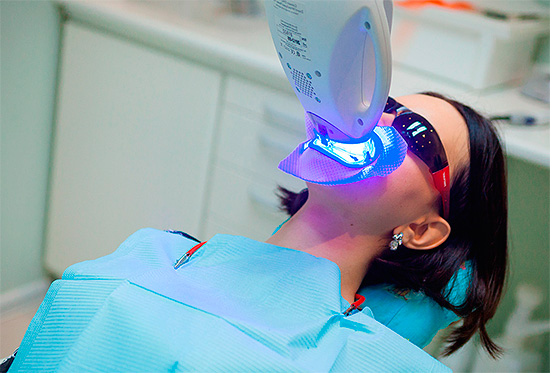
Over the past 5 years, photo-whitening has become one of the most popular dental services in many countries around the world. In Russia, it took root for a relatively long time due to the high cost of equipment and the low solvency of the population, but in recent years this procedure has been recognized in our country, as evidenced by numerous reviews on the Internet.
On a note
By the way, not all clients have enthusiastic responses about the effectiveness and consequences of photobleaching of teeth (we will discuss the reasons for this below). Moreover, there are some rather pitiable stories. Therefore, before making a final decision about whether you need such a service, you should study the issue in more detail, figuring out whether the procedure of teeth whitening is really worth the money spent on it, as well as what happens with the teeth and what negative points it is worth in advance keep in mind.
For a start, it is useful to know that photobleaching of teeth is only one of the varieties of professional (cabinet) whitening of tooth enamel, during which it is possible to lighten it up to 12 tones in one visit to the dentist.
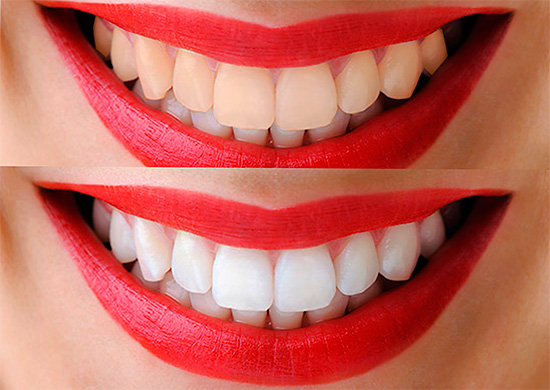
The principle of the procedure is quite simple: gel coated on tooth enamel containing hydrogen peroxide derivatives (or itself) provokes a chemical reaction with simultaneous penetration of active components into the thickness of the darkened enamel, and a special llama emitting special light is an effective catalyst for this process. It is under the influence of the lamp that the oxidation of pigments inside the enamel, which stain the tooth, occurs more quickly and actively.
Therefore, the price of photobleaching of teeth is primarily tied to the equipment for the activation of the whitening gel. The result and speed of lightening of the enamel, as well as safety for the mouth and teeth, depends on the properties of the lamps used (or LEDs).
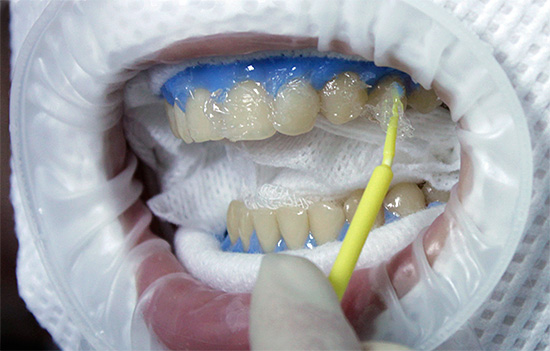
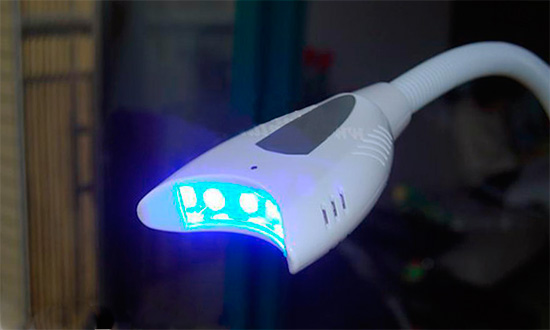
It is interesting
Surely you know that hydrogen peroxide has well-pronounced bleaching properties. So, if the process of discoloration (almost any colored substance) is carried out with simultaneous exposure to ultraviolet light or just bright lamps, then a chemical reaction,and it is more correct to even say a photochemical reaction will proceed much faster, and often its depth will also be higher (light quanta promote the release of active oxygen from peroxides).
Here, in fact, these catalytic properties of light and is used in practice in the photo-bleaching of teeth. This is the key feature of the technology - the whitening effect is achieved much faster than if the process were conducted in the old manner, without the use of light bulbs.
Photobleaching teeth and its varieties
Currently, four types of photobleaching of teeth are actively used, depending on the type of lamps used:
- Ultraviolet;
- Halogen;
- LED;
- Laser
The designs of some lamps provide both halogen and LED radiation. Ultraviolet teeth whitening, popular about 5-7 years ago, is gradually losing ground due to significant heat release during the procedure, which creates the danger of heating the tooth and even pulpitis develops in severe cases. But laser teeth whitening, on the contrary, is gradually becoming more and more popular.
It is interesting
However, it is not yet possible to completely abandon ultraviolet radiation in dentistry. For example, a lamp with ultraviolet radiation with a wavelength of about 450 nm is used for curing the so-called “light” fillings. Does the tooth heat up? Of course, yes, but the average curing time of one layer of the filling is only 15-20 seconds, while for teeth whitening it is necessary to irradiate with ultraviolet light for 10-15 minutes continuously.
If you immediately touch the “light” seal with the tongue after hardening with a lamp, you will notice that the seal has noticeably warmed up (largely due to the chemical reaction occurring during curing). In case of violation of the material handling technique, for example, when applying a too thick layer of fillings to a tooth and its prolonged irradiation with an ultraviolet lamp, it can heat up very much - up to a thermal burn of the pulp with the transition to pulpit.
Photobleaching of teeth is carried out at the reception at the dentist in several stages. The preparatory stage for the photobleaching procedure itself is to carry out professional oral hygiene. Without this, you can not start any bleaching technique. Generally speaking, mechanical cleaning of teeth from plaque and stone can also be conditionally called “bleaching” (more precisely, lightening), since for most people after such a procedure, the teeth are already much lighter.
After the preparatory stage, the enamel cleared of dental deposits is evaluated according to the standard scale of hues of the tooth color and the original color is fixed “before bleaching”, and then proceed to the second stage - the photobleaching procedure itself. At this stage, a thorough isolation of the mucous membranes is carried out with special means: the lips and cheeks are isolated with the help of special films and napkins, and the gums are treated with protective compounds (liquid cofferdam, which forms a protective film when frozen). All this is necessary so that the aggressive whitening gel does not cause chemical burns of soft tissues.
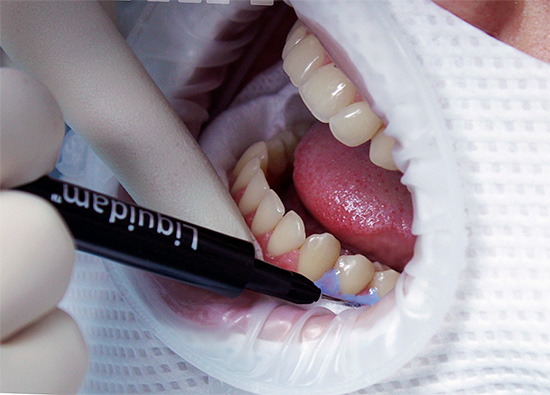
On a note
In such a thorough protection of the soft tissues of the oral cavity is a significant advantage of desk whitening of teeth from similar home methods - with the help of all kinds of whitening pencils, gel strips and cap.Quite often there are reviews of people who, after applying bleaching agents at home, later observed a rather eerie picture, when the burned pieces of the gums literally exfoliated flaps.
At the third stage, the active gel is applied to the surface of the enamel of the dentition and irradiated with a lamp for 10–20 minutes. After removing the gel, the result obtained is evaluated according to the color scale, and if there is not enough result, the procedure is repeated again. The main criterion for this decision is the correlation of the additional effect of the continuation of manipulations with the risk factors for the enamel of the teeth (with each procedure there is its demineralization and violation of the natural structure).
On average, all stages of the photo-whitening procedure collectively last about one hour. In case of insufficient whitening of the enamel, the process can be repeated in about a week.
Ultraviolet bleaching is considered a classic of the genre. However, despite the rapid achievement of the effect of whitening, this variant has a lot of minuses. In addition to the risk of overheating of the teeth, burns of the lips, oral cavity can also occur, and in case of violation of the technique of work, even hyperpigmentation (tanning) of the lower third of the face may occur.In rare cases, the appearance of dermatitis, atrophy of the epidermis, as well as the development of malignant tumors.
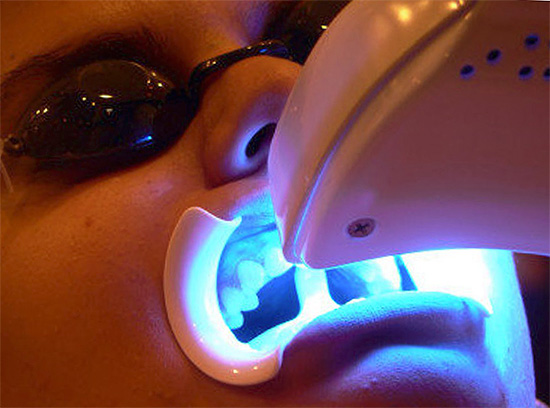
A halogen plant is an apparatus whose source of light is a halogen lamp (that is, in essence, it is the same incandescent lamp, but an improved one that can produce a brighter light).
In the case of the so-called LED photo-whitening of teeth, sufficiently powerful LEDs are used as light sources (give bright cold light).
When laser teeth whitening, you can not be afraid that this same laser will drill a hole in your teeth or somehow damage the enamel - in this case the power of light radiation is much lower than that of a surgical laser and its analogues.
The main advantages over homemade bleaching
Most household teeth whitening methods significantly inferior to desk photo whitening in terms of efficacy and safety. Perhaps the most dubious group of home-made bleaching agents are various bleaching pencils, strips and standard light emitting caps, especially those produced in China.
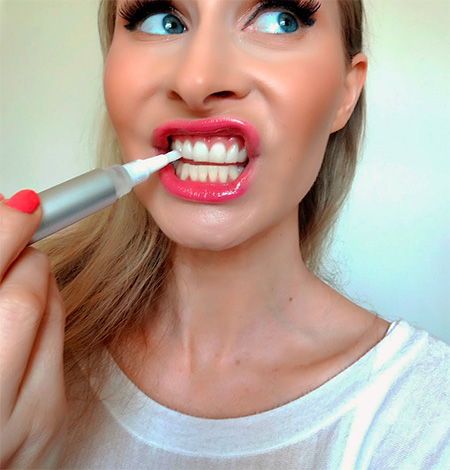
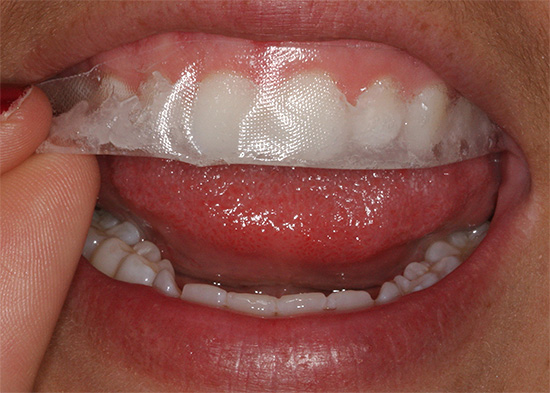
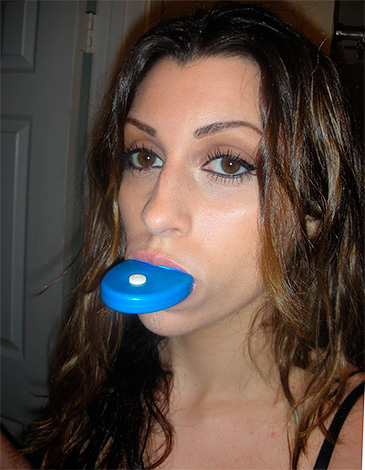
Every year more and more cases of burns of the oral mucosa are recorded by the active components of strips and pencils, the exposure of which on the gums and mucous lips (cheeks) can reach 20-30 minutes and even an hour - if used improperly, soft tissue necrosis will be provided during this time. The occurrence of gingivitis or inflammation of the marginal gum with bleeding phenomena can provoke even a high-quality home-made bleaching agent, since not every person is able to ideally install, apply, fix the bleaching agents and control the process to the full. The consequences of such experiments can be different, up to the need for plastic gums at the dentist-surgeon.
Feedback
“My teeth got naturally healthy, but only yellow. A friend persuaded to try to whiten the whitening strips, so I chased after the snow-white smile. With this horror, I have not yet encountered. I did everything according to the instructions, then I sat and suffered a burning sensation. And here's the result: the teeth were as yellow as they were! On the other hand, the gum burned itself all over, the skin turned white, and it began to fall off. The pads on the fingers are even white.So I will not advise anyone, for my own money, to spoil health ... "
Ekaterina, Moscow
That is why indoor photo-whitening of teeth, even despite the use of higher concentrations of hydrogen peroxide, is a safer procedure due to close monitoring by a specialist. Although it cannot be called absolutely safe, of course, because of the risk of a serious disruption of the structure of enamel during bleaching, which is often manifested by very severe pain in the teeth.
Additional advantages of photobleaching of teeth before home methods:
- High efficiency - you can lighten the enamel up to 10-12 tones, while using home-made bleaching agents you can only dream about it (see the example in the photo below);
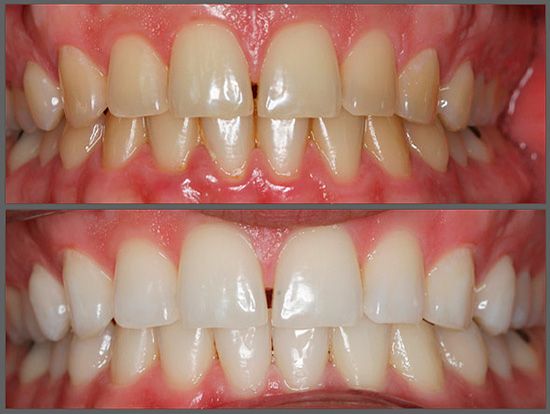
- High speed of obtaining the desired effect - no need to spend weeks on the regular use of ineffective means, it is enough one or three times to go to a specialist to get the desired result;
- The ability to immediately eliminate the side effects of the procedure, in particular, the increased sensitivity of enamel.This is achieved by carrying out the so-called remineralizing therapy - the enamel is saturated with lost mineral components (calcium, phosphorus, fluorine).
- The ability to simultaneously eliminate plaque and tartar, which in general has a very positive effect on the general hygienic situation in the oral cavity (fewer bacteria, less odor from the mouth, significantly lower risk of gum inflammation, etc.).
A number of specialists distinguish in a separate group the methods of home bleaching on the basis of manufactured individual caps. This method of whitening enamel is characterized by increased safety: the whitening components of the gel have a lower concentration and are applied to an individual cap made on the impression of the teeth at the dentist. At the same time, only the surface of the teeth is covered, with minimal risk of gel leaking towards the gums.
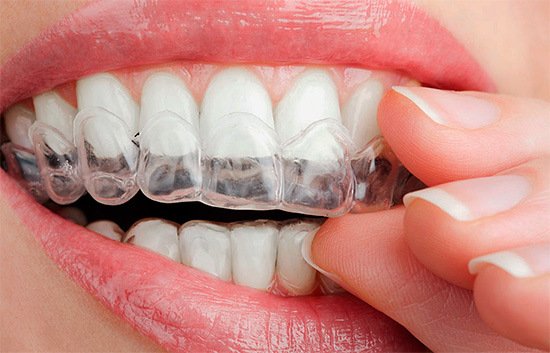
The main disadvantage of this type of home whitening before the desk photo whitening is the reduced rate of achieving the maximum result. If it takes about an hour to whiten teeth for 5-7 or more shades using photobleaching,then you can achieve the same positive result with a home use of a mouthpiece from a dentist only with the help of 3-4 or more procedures, often taking 1-2 weeks.
ZOOM whitening system: pros and cons
Zoom teeth whitening was developed by Discus Dental, Inc., and is today one of the most popular types of whitening, in which halogen and LED lamps are used to activate a special gel.
The whitening gel applied to the enamel surface contains 32% hydrogen peroxide (this is a very high concentration). The components of the gel actively penetrate the surface layer of the enamel, and thanks to the light of the lamp, the enamel-dyeing organic matter is effectively and fairly quickly discolored.

The effectiveness of photo-whitening of teeth according to the Zoom system can reach 10 shades at a time.
Let's now see what steps the procedure is composed of:
- Before the procedure, the oral hygiene occupancy mentioned above is carried out: they clean the dental plaque and stone from all surfaces of the teeth.
- At the second stage, the oral mucosa is isolated with a special protective material.
- At the third stage, the surface of the teeth is treated with a whitening gel and a special lamp is supplied to activate its components. Under the influence of light from the lamp, active oxygen is released from the gel, capable of oxidizing enamel-dye pigments. One procedure lasts about 15 minutes, but to achieve high results it may take another 2-3 sessions on the same day.
- After removing the whitening gel from the enamel surface, the dentist conducts its fluorination with saturated fluorine-containing compounds. As with other types of photobleaching, the doctor warns about the possible sensitivity of teeth, which can last several days, as well as about the methods of its prevention and treatment.
After teeth whitening using the Zoom technology, a so-called “white” diet is necessarily assigned: drinks and products that can stain tooth enamel again (wine, chocolate, brandy, etc.) are excluded, and it is strictly forbidden to smoke.

Advantages of teeth whitening system Zoom:
- High aesthetic effect in just 1 dentist visit (you can often lighten enamel more than 8-10 shades);
- Saving of time (the session lasts no more than 1 hour);
- Long-lasting whitening effect, subject to a white diet: 1-2 years or more;
- The relative safety of the procedure itself is subject to strict adherence to the instructions.
The photo below shows how teeth can look before and after photobleaching with the Zoom method:
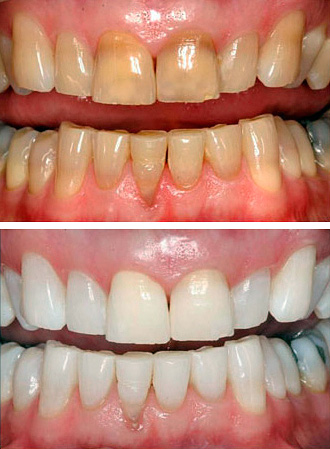
However, it is also worth mentioning the disadvantages of this technology:
- High prices for the service;
- Great risks of development of enamel hypersensitivity (especially for people with initially “thin” enamel - see the review below);
- The need to observe the “white” diet for several years (by the way, few people in practice are ready to give up for a snow-white smile from coffee or cigarettes);
- The need for mandatory restoration of the damaged structure of enamel with the help of remineralizing and fluorine-containing preparations. And most often requires a course of treatment;
- In rare cases - the effect of uneven teeth whitening stains.
Feedback
“A month ago I went to a paid clinic in Moscow to treat a pair of molars, there I was offered to do photo-whitening. The doctor was so courteous and pleasant that I did not even doubt that everything would be OK, well, except that just a little ... The procedure lasted about 30 minutes.She lifted my lips and cheeks with some kind of rubber thing, applied gel and began to shine a light in my teeth. In the end, we compared the results before and after photobleaching, I was pleased with the color, said thank you and went out into the street. It was January. As soon as I tried to smile, I was shot through the pain of cold air, so I reached the house with my mouth closed.
In short, the sensitivity still has not disappeared, although I brushed my teeth with fluoride paste and rinsed with a means for sensitive teeth. But, in general, it is possible to endure, and there is no such sharp pain: if something is very cold I take a sip or if I start brushing my teeth strongly. And I am very pleased with the color, it is what I wanted, I can say Hollywood. Well, beauty probably requires sacrifice. ”
Marina, Kazan
Contraindications to whiten teeth
From a professional point of view, it is advisable to distinguish absolute and relative contraindications to photo whitening of teeth. The first category concerns cases when the procedure cannot be carried out categorically, even if the client really wants (or wants the doctor from a commercial point of view) - in order to avoid causing serious bodily harm.

These include:
- Intolerance to the components of bleaching agents (allergy and its severe forms: angioedema, anaphylactic shock);
- Pregnancy and feeding period;
- Pathological abrasion of enamel, pronounced erosion, wedge-shaped defects. Photobleaching with such non-carious lesions of the teeth can lead to an impervious enamel sensitivity, which can create preconditions for the removal of pulp (“nerve”) from a large number of “innocent” teeth;
- Orthodontic treatment. When correcting the bite with the help of braces, bleaching is incorrect either from the point of view of logic (most often the clasps and plates are attached to the outer side of the teeth) or from the point of view of medical considerations - after removing the structure, the enamel will be spotty.
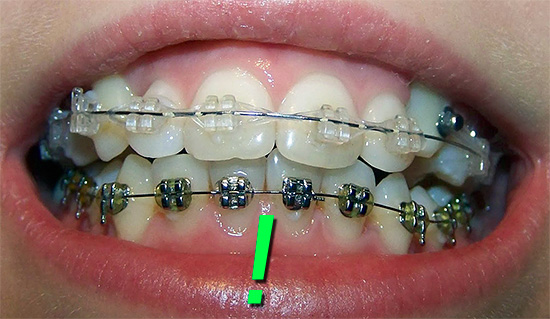
Relative contraindications for photobleaching of teeth:
- Age up to 18 years. From the point of view of common sense, it is absolutely not recommended to whiten teeth up to 15-16 years. Under certain conditions, photo-whitening at 16-17 years is possible, but taking into account the individual characteristics of a person;
- The client has caries and its complications (pulpitis, periodontitis), acute forms of gum inflammation.In such cases, whitening can be carried out only after the rehabilitation of the oral cavity;
- The presence of a large number of fillings on the front teeth or a violation of the fit of the seal. It is possible to carry out bleaching, if the seals are without violations, but after photobleaching they will look much darker (like “patches”) and with a high probability you will need to replace them all. If the seal fails to adhere during the photobleaching procedure, a sharp pain in the tooth can occur when the gel penetrates under the filling, which is fraught with even medical pulpitis (after all, if no measures are taken, hydrogen peroxide will inevitably lead to pulp necrosis).
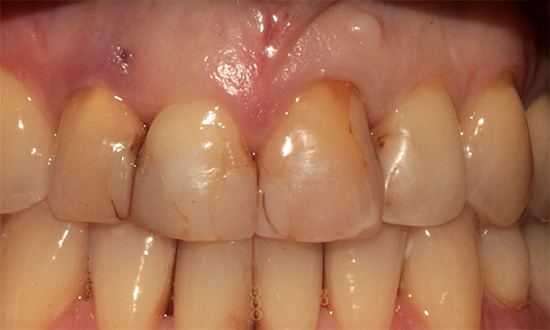
Feedback
“I did photo-whitening last year, in America. I got enamel from my dad, strong, good, but yellowish. The procedure was painless, sat under the lamp with blue light as comfortable as possible. The doctor warned me that discomfort in the teeth was possible in the first days, but it was not there. Either the enamel was so invulnerable, or the fluoridation of the teeth after the procedure helped, but there was no pain. The result struck me: my teeth became the same white as in my youth.True, this color was kept for only a few months, as I didn’t stand it in 2-3 months and started to break free (anniversary after anniversary): wine, brandy, good cigars, hookah. It became a shame to see the yellowed teeth again, so a couple of months ago I made ZUM again, I will sit on the clarified juices, milk, water and rice, but it's beautiful. That, my dear, is worth it. ”
Anna-Maria, Moscow
Complications after photobleaching: when you can be patient, and when you should see a doctor as soon as possible
It should be understood that photobleaching of teeth is a cosmetic procedure, which is more related to the category of beauty and perfection, but far from medicine and health. A number of specialists generally equate this procedure with breast augmentation, correction of the nose, lips, etc., the list goes on and on.
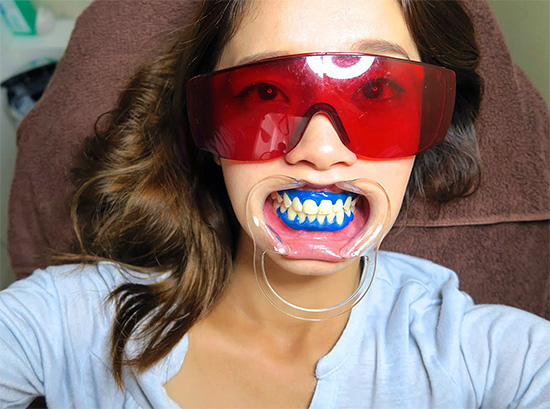
Therefore, before registering for photobleaching of teeth (whatever it is - even the most modern, using LEDs, or even laser), you should consult with your relatives, loved ones, listen to the reviews of "experienced", evaluate the pros and cons, see the results "before and after". And then you have to make a decision: is it worth breaking the natural structure of enamel for the beauty of your smile? ..
If the desire for beauty outweighs the obvious risks of the procedure, then it is important to be prepared for possible complications after photobleaching.
The first place in the ranking of complications after photobleaching of teeth, as evidenced by numerous reviews on the Internet, is the increased sensitivity of teeth. And someone will be lucky only to walk a couple of days with the sensitivity of teeth from cold, hot, etc., and in some people the feeling of sharp pain in the teeth can be found right in the dentist’s chair under the light of the lamp used to activate the whitening gel.
If very severe pains occur in the doctor’s chair, it makes sense to immediately abandon further sessions, due to the fact that this will not only turn into painful conscious deterioration of enamel, but may also create real prerequisites for the need to remove the pulp from some teeth (for example when the gel penetrates under the old fillings).
After the procedure of photobleaching of teeth, the dentist will conduct a course of remineralization and (or) fluoridation of the enamel, as well as prescribe home remedies for the prevention and treatment of hypersensitivity to the teeth: pastes, gels, etc.In those cases, if the painful sensitivity does not pass more than 4-5 days, or the teeth ache so that painkillers are required, it is urgently necessary to consult a dentist for help.
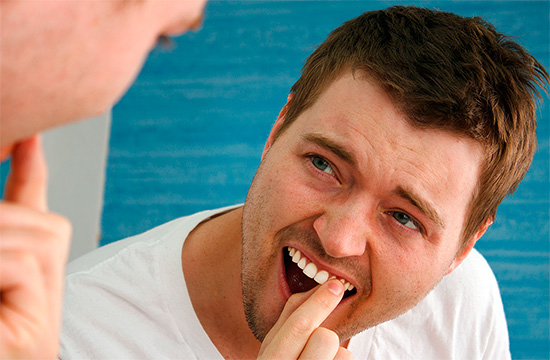
Feedback
“I did this same Zoom today. It took three sessions of 15 minutes, but I stopped this unhealthy orgy at the beginning of the second session, at about the fifth minute. I just told the doctor to get behind my teeth. At that time it was terribly painful, my teeth began to ache terribly and ache under the gel layer. The dentist persuaded a long time to continue the procedure, but the next time, when everything settles down. The stump is clear, give her the money, but I still want to live with my teeth. So I do not recommend this case to anyone, better take a good whitening paste. Yes, I forgot to say about the color: after this photojust, the teeth became clearly lighter, but the whiteness was somewhat unnatural, and the imperfections of the enamel were also visible. My personal advice: think carefully before you climb into the embrasure ... "
Olga, Krasnoyarsk
Other possible complications after photobleaching of teeth:
- The effect of uneven (non-uniform) teeth whitening, that is stained.Heterogeneous whitening of enamel occurs due to the different activity of the components of the whitening gel in different zones on the tooth surface.
- After the procedure, the fillings on the teeth sometimes look like patches and may need to be replaced.
- In rare cases, severe burns of the oral mucosa and gums, especially the edge, are possible. If gum hyperemia occurs after bleaching, then such light burns themselves go away without treatment. In more severe cases, it may even require plastic gums and its long-term recovery.
In case of gross violations of the technology and the application of the dubious quality of the bleaching agents, a serious injury of the enamel is possible, right up to chipping immediately after the procedure. This can result in not only an aesthetic defect, but also unbearable pain, the relief of which is possible only after the treatment of the tooth with a filling, or even after preliminary extraction of the “nerve” from the canal.
The cost of photobleaching teeth
The price for the procedure of teeth whitening is formed taking into account the following factors:
- Cost of used equipment and materials.At the moment, even the purchase of consumables (whitening gels, insulating materials, fluorinating drugs, etc.), considering that almost 100% of these are imported drugs, cost a pretty penny to any clinic, therefore the pricing is appropriate. In other words, the price will be quite high.
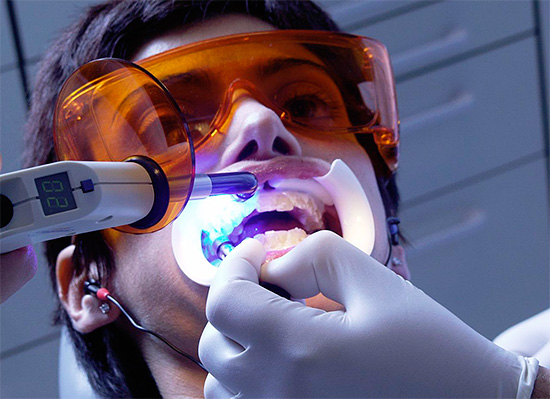
- The rating of the clinic and the associated costs of its promotion. It is not necessary to explain that the more the clinic has spent money on its name, the higher will be the cost of its services, including on photobleaching of teeth.
- Qualification and professionalism of specialists working in the clinic. Due to the high level of knowledge, skills and skills (obtained by hard work), the dentist can minimize the risks and make the photo-whitening procedure comfortable for the client and as safe as possible - as far as possible. Also, do not forget that only a doctor who is interested in preserving the patient's health will be able to individually select alternative ways of photo-bleaching to make a smile more beautiful (veneers, luminirs), to improve the color indicators of enamel without harm for her if teeth whitening is categorically contraindicated . Only for this you have to pay good money.
On average, the cost of photobleaching of teeth today is in the range of 6-8 to 20-25 thousand rubles, depending on the clinic.
Interesting video about the system of photobleaching teeth Zoom
An expert on the important nuances of the teeth whitening and lightening procedure.

